Reading Time: 12 Minutes Only
Hey There! Have you ever wondered how our stored food in the refrigerator remains fresh for a long time? Do you have any idea why the air in your refrigerator is always cold? If you don’t have knowledge about either of these questions, then this post is for you. So, you are welcome to another article on our blog. Today, we have brought to you a very interesting article about Refrigerant Gas where we will discuss which gas is used in refrigerators and their related aspects.
Actually, the gas we are talking about here is commonly called a Refrigerant, which is generally found in a liquid or gaseous state. Generally, refrigerants are used for cooling purposes in Air Conditioners, Refrigerators, Freezers, etc. But, today we will also talk about how a refrigerant works in a refrigerator. So, let’s start!
But, before that let’s know what is refrigerant.
What is a Refrigerant?
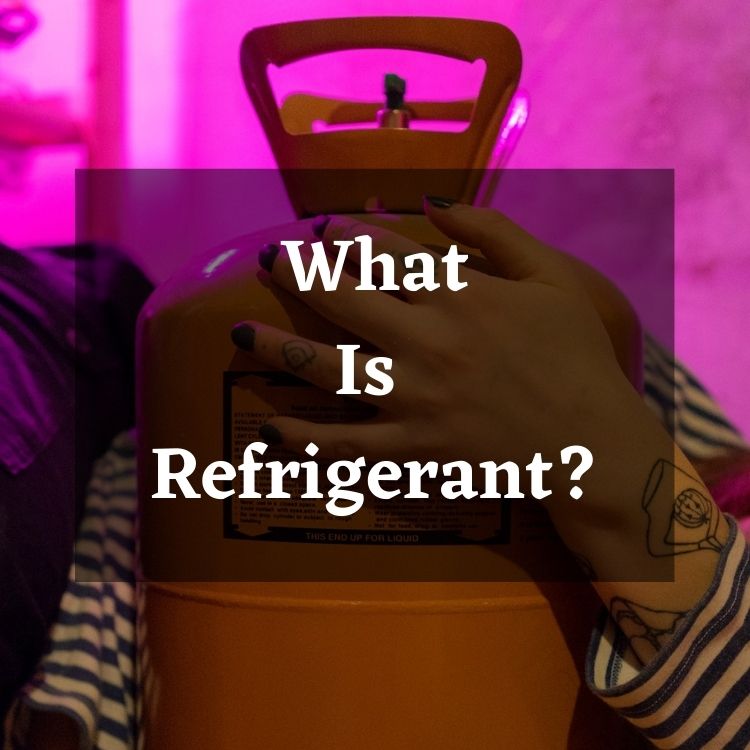
A refrigerant is a kind of chemical fluid, which consists of a mixture of a few chemical compounds. It is basically used in Refrigerators, Freezers, and Air Conditioners for the purpose of making the environment cooler within a particular area.
In these machines, it passes through a refrigeration system/cycle, in which by increasing and decreasing the pressure of the refrigerant fluid, the refrigerant converts from the fluid into the gas form automatically and vice-versa. Due to this, it cools by absorbing all the heat from the surroundings with the help of components like a Compressor, Condenser, and Evaporator.
The refrigeration cycle is a continuous process that really helps in keeping the stored food healthy and fresh for longer. Without a refrigerant, the conditioning, cooling, and freezing of air can not be possible. This whole process is used in commercial and domestic refrigeration and air conditioning systems.
As we now know about what is refrigerant, let’s move further toward the question, How does a refrigerant work in a refrigerator or fridge?
How does refrigerant work in a refrigerator?
As I said above, without a refrigerant we cannot imagine air cooling, conditioning, and freezing technology for now. In the refrigerators, it undergoes through the refrigeration system, where the four major components such as a Compressor, Condenser, Expansion Valve, and Evaporator help to achieve its purpose.
In the process, its state changes from liquid to gas and vice-versa with the help of above mentioned four components. Let’s discuss them step-by-step in the refrigeration cycle or system precisely. So, this all begins with the Compressor, where the refrigerant is stored. So, let’s start with the very first step,
Step 1: When the power supply turns on, the compressor pulls the refrigerant and starts increasing its temperature by narrowing down the inside space. Due to this, the refrigerant becomes hotter turns from liquid to gas state, and moves ahead towards the Condenser.
Step 2: When it reaches the Condenser Coil, it is still in the form of high-pressure gas, but due to the fans around the condenser coil the high-pressure gas cools down. And, after that, the condenser sends it to the expansion valve.
Step 3: After getting cooled down by the Condenser the refrigerant converts into a high-pressure liquid and comes to the Expansion Valve. Do you know that the Expansion Valve is also called a Capillary Tube? It helps in converting refrigerant to low-pressure liquid and sends it ahead to the last component Evaporator.
Step 4: Lastly, in the Evaporator the refrigerant is in the form of low-pressure liquid. With the help of an Evaporator, the refrigerant turns back into the form of low-pressure gas. And there, the Evaporator Fans make this cool air spread all around inside the refrigerator and help in preserving food.
So, that’s all about the refrigeration cycle, where the refrigerant plays a vital role in providing cool air.
History of Refrigerant
From the mid-19th century to the 20th century, there are toxic or flammable refrigerants were used in refrigerators or ACs. Those toxic or flammable refrigerants include Ammonia, Sulfur Dioxide, Methyl Chloride, Propane, etc. These refrigerants can prove to be very dangerous if they leak and can cause a fatal accident.
In consideration of this, according to Wikipedia, in 1928 an American mechanical and chemical engineer named Thomas Midgley Jr. created a non-toxic and non-flammable CFC (Chlorofluorocarbon) refrigerant. However, it was discovered that CFC refrigerants are dangerous to the environment or ozone. It contributed to producing the greenhouse effect and depletion of the ozone layer, which protects us from the harmful radiation of the sun’s UV rays.
In the 1980s, scientists found that CFCs were causing major damage to the ozone layer. After that, they decided to phase out CFCs by signing a Montreal protocol by the 12 European countries in 1989.
Types of Refrigerant gas used in refrigerators?
There are several types of Refrigerants available, but the following given below are the most commonly used refrigerants such as,
- R12 or CFCs (Chlorofluorocarbons)
- R22 or HCFCs (Hydrochlorofluorocarbon)
- R134a or HFCs (Hydrofluorocarbon)
- R600a or IsoButane or HCs (Hydrocarbon)
The refrigerant that has been phased out
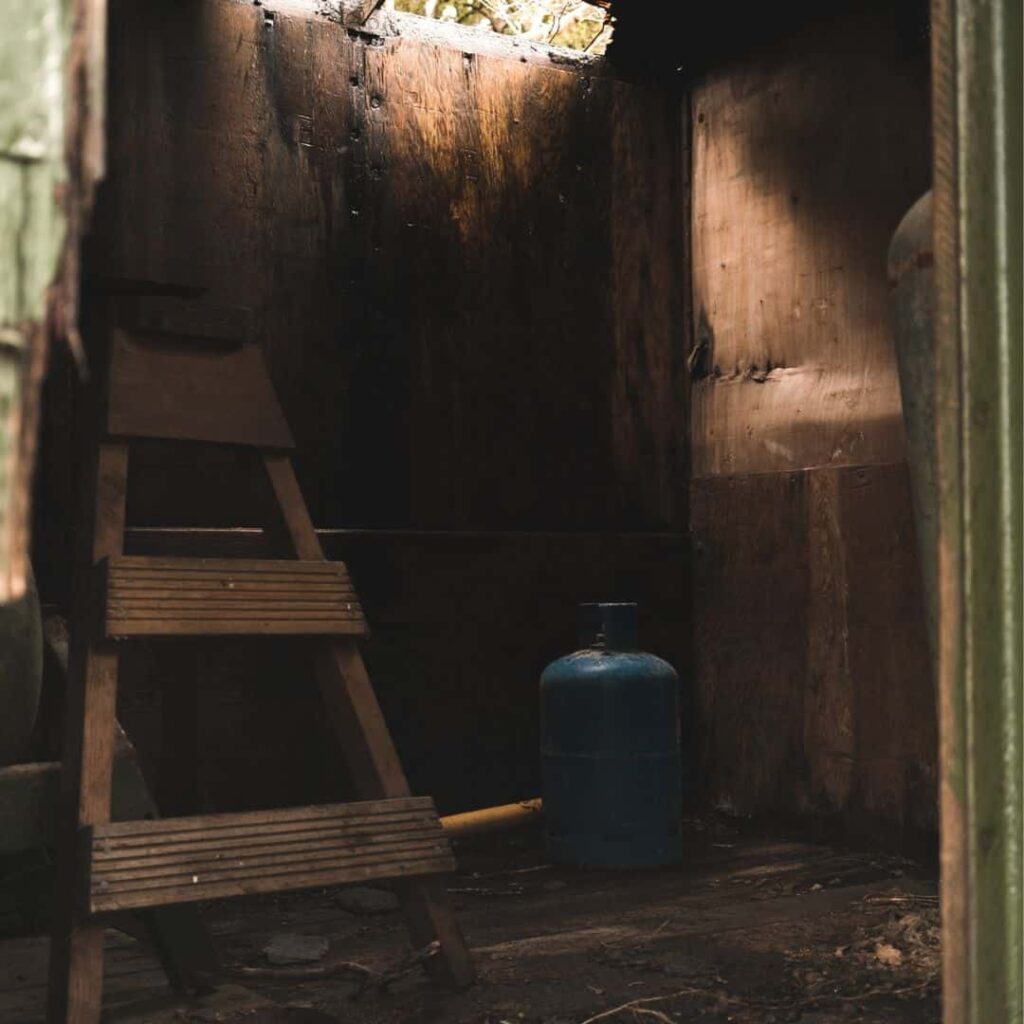
CFCs (Chlorofluorocarbon) were the most common refrigerant used in the 20th century after being created by Thomas Midgley Jr. in 1928. Before CFC refrigerant gases, toxic gases were used as we discussed above. So, because of the toxicity of those gases, companies started preferring CFCs for producing domestic refrigerators.
Due to this big change, CFCs gained immense popularity in the refrigeration industry and it became the most common refrigerant to be used at that time. But in the 1980s, when scientists found that the CFCs were contributing to producing the greenhouse effect and becoming the biggest reason for ozone depletion, they decided to phase out this gas.
After CFCs, HCFCs were phased out in some countries like India. On 1st January 2020, India completely phased out (HCFC) R-141b, which is (1,1-Dichloro-1-fluoro ethane), under the Ozone Depletion Substances (Regulation & Control) Amendment Rules, 2019 issued under the Environment Protection Act, 1986. (Read the full Press Release)
In 2021, the cabinet of India approved the ratification of the Kigali Amendment to the Montreal Protocol on substances that deplete the ozone layer for phasing out HFCs. (Read the full Press Release)
Due to the technological advancements nowadays, we can expect that we will surely invent or discover a refrigerant gas in the future that will neither harm humankind nor the environment. Now, let’s move further to “how CFCs deplete the ozone”.
How does a CFC gas deplete the Ozone Layer?
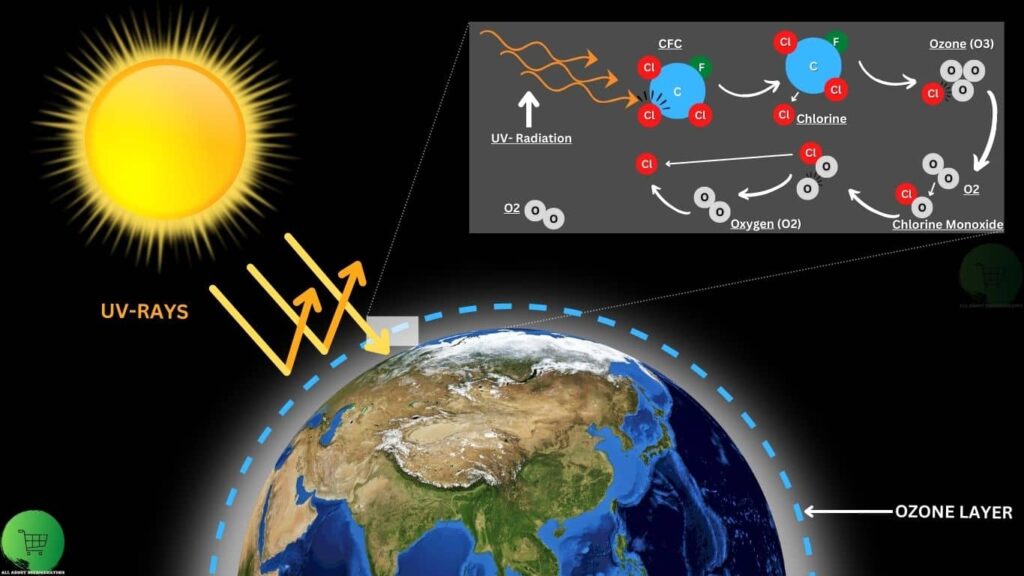
Most of you guys are familiar with the Ozone layer, which is made up of tri-oxygen (O3). The main culprits behind this problem are the chemical compounds of CFC gas such as Chlorine, Fluorine, Carbon, etc. Once the CFC gas leaks or enters the atmosphere, it reaches the Stratosphere where it breaks up due to the sun’s ultraviolet radiation and releases a chlorine atom. When chlorine reacts with ozone (O3) it splits into Chlorine Monoxide (ClO) and Oxygen (O2), due to which the ozone molecule is destroyed.
Further, due to single atoms of oxygen also present in the atmosphere, they react with Chlorine Monoxide (ClO). Afterward, the Chlorine Monoxide split into Chlorine (Cl) and Oxygen (O2), and the cycle continues. Every time at the end of the cycle, the Chlorine atom is released again and again, due to which, it reacts with Ozone repeatedly and destroys it tremendously.
Currently Used Refrigerants in Modern Refrigerators in India
- R22 (Chlorodifluoromethane) or HCFC (Hydrochlorofluorocarbon): R-22 is a commonly used refrigerant gas in older refrigerators and ACs, but after it was found as a reason for ozone depletion, it got phased out.
- R134a or (Tetrafluoroethane) or HFC (Hydrofluorocarbon): Tetrafluoroethane (R-134a) is a good advancement in refrigerant after CFC got phased out, as it has a zero ODP level. This feature makes it an ozone-friendly gas, which means it does not contribute to the depletion of the ozone. But, it does contribute to global warming. It is one of the most used gases in the refrigerator today, due to its non-toxic and non-flammability properties.
- R-600a or (IsoButane) or HC (Hydrocarbons): Isobutane (R-600a) is also one of the refrigerants used in refrigeration but at very low levels. Due to its nature of flammability unlike CFCs, HCFCs, etc. However, it provides better energy efficiency to refrigerators and helps in saving the environment as well. But, due to safety concerns, it is not preferred to be used as an alternative to CFCs or HCFCs. R-600a is commonly used in small-size refrigerators in India. It is one of the greenest refrigerant options available as compared to others because it has zero ODP (Ozone Depletion Potential) and very minimal or close to zero GWP (Global Warming Potential) level.
- R-410A or HFC: R-410A is used as a replacement for R-22 gas, as it is an ozone-friendly gas. It is basically used in domestic Air Conditioners in India, as it is a non-toxic and non-flammable gas. This feature makes it usable in domestic indoor rooms and it does not harm humankind. Although its competitor HFC gas R-32 is better than this in terms of GWP, that doesn’t matter as both are HFCs. R-410 is a blend of two HFC gases R-32 & R-125.
- R-32 or (Difluoromethane) or HFC: R-32 is again an HFC, which is commonly used in domestic Air Conditioners like R-410A as a competitor. It is quite better than the R-410A in terms of GWP, as I said above. It has a lower global warming potential than R-410A, but both are ozone-friendly refrigerant gases.
So, right above we have discussed some commonly used refrigerants in India. Wherein, we have found that HFCs are the widely used refrigerant in India such as R-134a, R-410A, and R-32, etc.
Classification of commonly used refrigerants with their ODP & GWP Index
| Chemical Name | Refrigerant Type | ASHRAE Number | Ozone Depletion Potential (ODP) | Global Warming Potential (GWP) |
|---|---|---|---|
| Tetrafluoroethane | HFC | R-134a | 0 | 1300 |
| IsoButane | HC | R-600a | 0 | 3 |
| Propane | HC | R-290 | <0(smog) | 3.3 |
| N/A | HFC | R-410A | 0 | 2088 |
| Difluoromethane | HFC | R-32 | 0 | 677 |
Which gas is used in Refrigerators? – FAQs
Ans: Ozone depletion happens because of the release of Chlorofluorocarbons, which are used as a refrigerant in refrigerators. What it does is that the chlorine atoms of CFC break down when it comes in contact with UV rays. After that, it causes the breakdown of the molecules of ozone, which is O₃
Ans: Global Warming is known as a gradual increase in temperature of the whole world due to an increase in levels of poisonous gases in the atmosphere such as CFCs, carbon dioxide, and other pollutants. These gases contribute to the formation of the greenhouse effect that enhances global warming year by year.
Ans: After phasing out CFC gas in most developed countries due to its ozone-depleting properties. India also stopped using this refrigerant gas like other countries and replaced it with HFCs, which proved to be a better alternative to CFCs and HCFCs. The most common HFC refrigerant gas used in India is R-134a (1,1,1,2-Tetrafluoroethane), which has zero ODP (Ozone Depletion Potential) level.
Another popular refrigerant used in India is R-600a (Isobutane). It has zero ozone depletion potential and very minimal or close to zero global warming potential. This gas is mostly used in small or mini-fridges. On the other hand, this gas proves very dangerous as it is flammable in nature.
For vehicle ACs in India the R-143a (1,1,1-Trifluoroethane), HFC is used most commonly with zero ODP, but a higher GWP level. On the other hand for room ACs another refrigerant is used named R-410A HFC, which is a better option than previously used R-22 (Chlorodifluoromethane), as R-410A has zero ODP, but has a higher GWP level like R-22.
Ans: If we talk about the best refrigerant gas for the refrigerator, then the R-600a (Isobutane) comes first on everyone’s list. Isobutane is a commonly used refrigerant with eco-friendly properties. It is one of the most eco-friendly refrigerant gases available right now. Other than its eco-friendly nature, it also provides good energy efficiency to refrigerators. But, after all these advantages, there is a big disadvantage backed with it, which makes it a dangerous and risky refrigerant. And, that is its high flammability, as it is a hydrocarbon (HC). So it is not preferred yet to be used more.
Ans: To recognize that your refrigerator is running out of refrigerant is very simple. When it happens, your fridge starts to smell unpleasant and your stored food inside will start spoiling too soon and produce an unpleasant smell as well. So, these are the signs that indicate that your fridge’s refrigerant is over.
Ans: Yes, you can do this by yourself, as there are many DIY tutorials available that can help you with. But in my opinion, you should call for a professional technician for that, who knows better than you how to do it properly. It can be too dangerous sometimes to cope with these toxic chemical refrigerants. Therefore, always entrust this dangerous work to the hands of a professional.
Ans: It costs you around ₹500 to ₹800 in India to refill the refrigerant in your refrigerator. But it can sometimes go ₹1000 at maximum.
Note: The above-mentioned prices are just an estimate. It may cost you more or less sometimes than the above-mentioned prices because it totally depends on the complication of the problem that occurred with your refrigerator gas.
Conclusion:
In this article, we have discussed, which gas is used in refrigerators nowadays, especially in India. I hope that after reading all this information carefully, you have got answers to all your questions related to it.
So, if you have concerns about the environment and atmosphere, then you should check the refrigerant that is used in the refrigerator before buying it. It is like a win-win deal, which is good for you and for the environment as well.
As per our recommendation, you should go for R134a, which is Tetrafluoroethane or Norflurane, or R600a, which is IsoButane. Both refrigerants are used in modern refrigerators and come with zero ODP. Isobutane is the greenest refrigerant gas available on the market nowadays, but due to its flammable nature, it can be dangerous sometimes. That is why it is used very rarely in conventional refrigeration systems compared to R134a.
So, tell us your thoughts about this article in the comments below. And, you can also tell us about the current refrigerant you guys are using in your refrigerator.
Cheers!
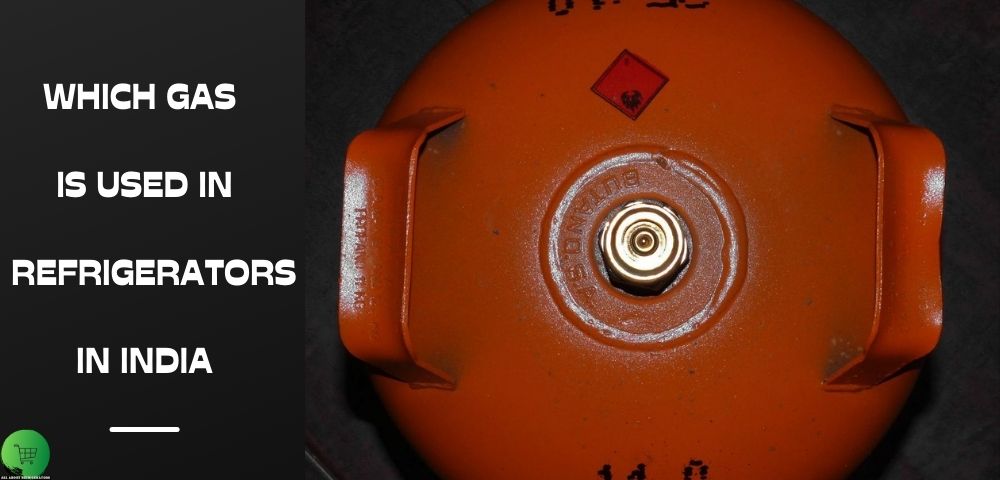
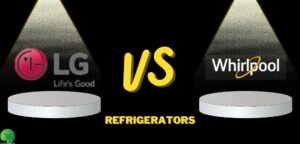



It’s a masterpiece of knowledge. It’s a well-written article about which gas used in refrigerators I’ll share this article with my readers.
Thank You.
I’m glad you liked the article.